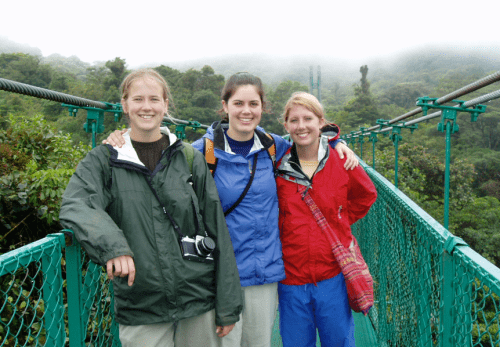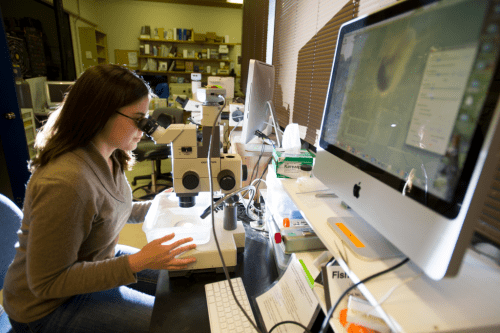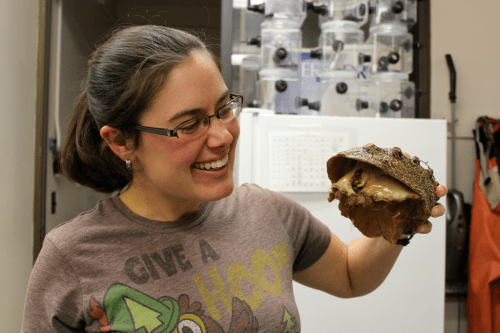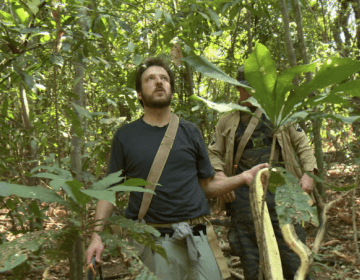From Costa Rica to California: One Study Abroad Alum’s Quest to Save an Endangered Species
Scientist. Educator. CIEE Alum of the Month. These are just a few words to describe CIEE Study Abroad alumna Kristin Aquilino, an Assistant Project Scientist at UC Davis Bodega Marine Laboratory who dedicates her time to saving the endangered white abalone. Abalone are sea snails found in many coastal waters whose meat is consumed as a delicacy and whose iridescent shells are used for jewelry and other mother of pearl decorations like guitar inlays. The white abalone is just one of 57 species in a group of herbivorous marine snails and is considered endangered as a result of overfishing, infections, and reproductive failure. Saving the species is Kristin’s passion. How did she become interested in this challenging work? What does study abroad have to do with it? We interviewed Kristin to find out this and more.
What motivated you to study abroad with CIEE in Monteverde, Costa Rica?
As an undergraduate at the University of Wisconsin – Madison, I was totally jazzed about ecology, biodiversity, and evolutionary biology. Few places in the world have as incredible biodiversity of plants and animals that evolved interesting ways to cope with their environments as Costa Rica. I also knew that putting myself slightly out of my comfort zone would help me grow as a scientist and as a person, and embarking on a journey that included backpacking in the rainforest was certainly a bit out there for a kid from Iowa who had hardly ever been camping.
What’s one of your best memories from your time abroad in 2004?
One of my favorite memories from my time in Costa Rica is of learning the theory of island biogeography from a beach on the Osa Peninsula. It was my first and only experience with “sand PowerPoint” – our fantastic instructor, Dr. Carlos Guindon, would draw keywords and figures in the sand with a stick, and our teaching assistants would advance his “slides” by sweeping palm fronds over what he had written so he could start anew. To this day, it is the best lecture I have ever attended.
The most impressive part of the experience was not just being able to plunge my feet in the sand during class while enjoying a backdrop of crashing waves and scarlet macaws, but being able to experience the concepts we were learning in action. After our lecture, we visited a nearby island and compared species abundances and ecological processes on the island to those on the mainland. This immersive, hands-on approach was what made this field course so much more impactful than my lessons that took place in lecture halls on campus.
How did your study abroad experience impact your education?
Observing natural history, asking and investigating my own scientific questions, building confidence, being surrounded by inspiring peers, witnessing the global, “real-world” impacts of science, understanding the context of science in society and how it affects people… all of these things made me a better naturalist, scientist, and human being.
My study abroad experience gave me a much more holistic appreciation of the earth and the way humans interact with it, which broadened my scope of interest when applying for graduate programs and pursuing future research questions. It also made me appreciate home; though I always had a passion for nature, I often didn’t appreciate the Great Plaines and rolling cornfields that surrounded me. Sometimes it takes something like an exotic rainforest to help you appreciate the wonders of the ecosystem in your own backyard.
What makes you so passionate about the white abalone?
Where do I begin? There is certainly a sense of purpose that comes with trying to correct past environmental mistakes. We humans were responsible for the decline of this species, and I believe that we have a responsibility to save them. Efforts to save an endangered species also allows for an excellent opportunity to engage in meaningful communication about the importance of science to our quality of life. I love opportunities to share our work through social media, video production, science outreach seminar series, and K-12 education.
I also have the pleasure of working with several amazing people and organizations. While the UC Davis Bodega Marine Laboratory leads captive breeding efforts, we work closely with other universities, federal and state institutions, aquariums, and aquaculture farms to do this work, which is overseen by the National Oceanic and Atmospheric Administration.
Most people have probably not heard of white abalone. What are five things everyone should know about the marine invertebrate?
- White abalone are a delicious marine snail that will go extinct very soon without our efforts to save them: We fished over 99% of them in the 1970’s, and the ones that remain are too far apart from one another to reproduce. This overharvest led to them being the first marine invertebrate to land a spot on the U.S. Endangered Species List.
- White abalone is one of seven species of abalone off the west coast of North America, and there are abalone on every continent except for Antarctica. Abalone are hugely culturally and economically important to communities worldwide, including coastal California; people eat them, make jewelry and guitar inlays out of their shells, and native people even used the shells as currency. My husband learned to harvest abalone from his uncle when he was a boy, and we can’t wait to teach our daughter to dive for them. Abalone are in the DNA of Californians and coastal inhabitants throughout the globe.
- White abalone and their congeners also possess ecological superpowers – they are like the Zambonis of the sea, maintaining a habitat that is perfect for lots of other animals to inhabit, and competing with species like urchins, that can wreak havoc on kelp forests when their populations go unchecked.
- White abalone are adorable. While many people appreciate the giant foot of these snails, so many don’t realize they also have “squee”-worthy faces. Few things bring me more joy than showing someone the beady, black eyes topping the mollusk's long, skinny eyestalks. They have personalities!
- We can save them. Captive breeding and outplanting was identified as the best way to rescue this species from the brink of extinction. We now boast more white abalone in captivity than exists in the wild. While this is a scary prospect for the wild population, it also presents a great opportunity to save them. With their wild habitat in relatively pristine condition, we should be able to get our captive-bred animals to thrive there and save this important species.
For updates about Kristin and her colleagues’ efforts to save white abalone, follow them on Facebook, Instagram, or Twitter!
Related Posts
A Lifelong Pursuit of Adventure: CIEE Alum on NBC’s The Island with Bear Grylls
A study abroad program is an adventure. For CIEE alum Rick Smith, his semester in Monteverde, Costa Rica was the catalyst for his pursuit of adventure as a lifestyle. Most... keep reading





